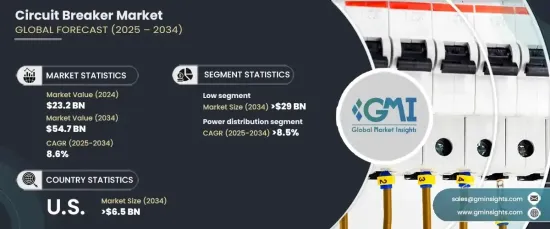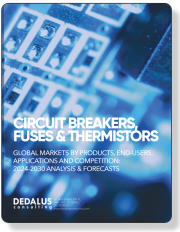
|
시장보고서
상품코드
1667097
세계의 회로 차단기 시장 기회, 성장 촉진요인, 산업 동향 분석 및 예측(2025-2034년)Circuit Breaker Market Opportunity, Growth Drivers, Industry Trend Analysis, and Forecast 2025 - 2034 |
||||||
세계 회로 차단기 시장은 2024년 232억 달러로 평가되었고, 2025-2034년 연평균 8.6% 성장할 것으로 예상됩니다.
이러한 성장은 기술 발전, 규제 기준 강화, 인프라 개발 수요 증가가 주요 요인으로 작용하고 있습니다. 여러 지역에서 전기 안전과 전력망 신뢰성에 중점을 둔 규제 강화가 시행됨에 따라 시장에서는 보다 진보된 회로 차단기로의 전환이 이루어지고 있습니다.

또한, 재생 가능 에너지원의 확대와 스마트 그리드 시스템의 개발은 원활한 에너지 공급을 보장하고 시스템 장애의 위험을 줄일 수 있는 효율적인 회로 차단기의 필요성을 더욱 높이고 있습니다. 신흥국 시장을 중심으로 한 인프라 개발의 발전도 회로 차단기 시장 확대에 큰 역할을 하고 있습니다. 그러나 첨단 회로 차단기의 높은 초기 비용과 현지 업체와의 경쟁은 특정 지역의 성장 속도에 영향을 미치고 있습니다.
| 시장 범위 | |
|---|---|
| 시작 연도 | 2024년 |
| 예측 연도 | 2025-2034년 |
| 시작 금액 | 232억 달러 |
| 예상 금액 | 547억 달러 |
| CAGR | 8.6% |
저전압 회로 차단기 시장은 에너지 효율, 안전 및 스마트 솔루션에 대한 수요 증가를 반영하여 2034년까지 290억 달러를 넘어설 것으로 예상됩니다. 전기적 위험에 대한 인식이 높아짐에 따라 저전압 회로 차단기의 상업용, 주거용, 산업용도에 대한 채택이 증가하고 있습니다. 기술 발전으로 인해 디지털 및 스마트 회로 차단기는 실시간 진단, 원격 모니터링, 예지보전 등의 기능을 제공하는 등 기술 혁신이 가속화되고 있습니다. 다양한 분야에서 안전 기준이 강화됨에 따라 신뢰성과 규정 준수를 보장하기 위해 고급 저전압 회로 차단기의 필요성이 더욱 커지고 있습니다.
배전 용도에 사용되는 회로 차단기 시장은 2034년까지 8.5% 이상의 CAGR로 크게 성장할 것으로 예상됩니다. 이러한 수요의 원동력은 전력망을 현대화하고 효율성과 신뢰성을 향상시켜야 할 필요성에 기인합니다. 송전망이 진화함에 따라 동적 부하에 대응하고 유지보수를 위한 실시간 모니터링이 가능한 첨단 회로 차단기가 필수적으로 요구되고 있습니다. 고전압 회로 차단기는 장거리 송전선을 보호하고 송전에서 안정적인 전력 흐름을 보장하기 위해 점점 더 많이 요구되고 있습니다. 이러한 차단기에 대한 수요는 신흥국 시장을 중심으로 한 인프라 개발의 발전과 재생 가능 에너지로의 전환으로 인해 더욱 강화되고 있습니다.
미국의 회로 차단기 시장은 전력망 현대화, 전기 안전 향상, 지속가능성 노력 등의 요인으로 인해 2034년까지 65억 달러를 넘어설 것으로 예상됩니다. 재생 가능 에너지의 통합과 스마트 그리드 채택으로 인해 다양한 부하를 수용하고 디지털 시스템과 상호 작용할 수 있는 첨단 회로 차단기에 대한 수요가 증가하고 있습니다. 인프라 업그레이드와 교통의 전기화가 진행됨에 따라 전력망의 안정성과 효율적인 배전을 보장하기 위해 저압 및 고압 회로 차단기에 대한 수요가 증가하고 있습니다. 미국 에너지부가 2023년에 발표한 전력망 강화 및 현대화를 위한 35억 달러의 투자는 전력망의 복원력과 신뢰성을 향상시키기 위한 지속적인 노력을 강조하고 있습니다.
목차
제1장 조사 방법과 조사 범위
- 시장의 정의
- 기본 추정과 계산
- 예측 계산
- 데이터 소스
- 1차 데이터
- 2차 데이터
- 유상
- 공적
제2장 주요 요약
제3장 업계 인사이트
- 생태계 분석
- 규제 상황
- 업계에 대한 영향요인
- 성장 촉진요인
- 업계의 잠재적 리스크&과제
- 성장 가능성 분석
- Porter의 Five Forces 분석
- 공급 기업의 교섭력
- 바이어의 교섭력
- 신규 진출업체의 위협
- 대체품의 위협
- PESTEL 분석
제4장 경쟁 구도
- 전략 대시보드
- 혁신과 지속가능성 전망
제5장 시장 규모와 예측 : 전압별, 2021년-2034년
- 주요 동향
- 저전압
- ACB
- MCB
- MCCB
- 기타
- 중위
- ACB
- VCB
- GCB
- 기타
- 고전압
- ACB
- GCB
- VCB
- OCB
제6장 시장 규모와 예측 : 정격전압별, 2021년-2034년
- 주요 동향
- 500V 미만
- 500V-1kV
- 1-15kV
- 15-50kV
- 50-70kV
- 70kV-145kV
- 145kV-300kV
- 300kV-550kV
- 550kV-800kV
- 800kV 이상
제7장 시장 규모와 예측 : 정격 전류별, 2021년-2034년
- 주요 동향
- 500A 미만
- 500-1,500A
- 1,500-2,500A
- 2,500-4,500A
- 4,500A 이상
제8장 시장 규모와 예측 : 설치 대수별, 2021년-2034년
- 주요 동향
- 실내
- 야외
제9장 시장 규모와 예측 : 용도별, 2021년-2034년
- 주요 동향
- 배전
- 변속기
제10장 시장 규모와 예측 : 최종 용도별, 2021년-2034년
- 주요 동향
- 주택
- 상업
- 산업
- 유틸리티
제11장 시장 규모와 예측 : 지역별, 2021년-2034년
- 주요 동향
- 북미
- 미국
- 캐나다
- 멕시코
- 유럽
- 프랑스
- 독일
- 스페인
- 이탈리아
- 영국
- 아시아태평양
- 중국
- 인도
- 일본
- 한국
- 호주
- 중동 및 아프리카
- 사우디아라비아
- 아랍에미리트(UAE)
- 카타르
- 남아프리카공화국
- 라틴아메리카
- 브라질
- 아르헨티나
제12장 기업 개요
- ABB
- Alfanar Group
- CG Power
- Eaton
- General Electric
- HD Hyundai Electric
- Kirloskar Electric
- LS Electric
- Mitsubishi Electric
- Powell Industries
- Schneider Electric
- Sensata Technologies
- Siemens Energy
- Toshiba International
- WEG
The Global Circuit Breaker Market, valued at USD 23.2 billion in 2024, is expected to grow at a CAGR of 8.6% from 2025 to 2034. This growth is largely driven by technological advancements, stricter regulatory standards, and the increasing demand for infrastructure development. As various regions implement stronger regulations focusing on electrical safety and grid reliability, the market is seeing a push toward more advanced circuit breakers.

Additionally, the expansion of renewable energy sources and the development of smart grid systems are further fueling the need for efficient circuit breakers that can ensure smooth energy distribution and reduce the risk of system failures. The rising infrastructure development, particularly in emerging markets, is also playing a significant role in expanding the circuit breaker market. However, challenges such as the high upfront cost of advanced circuit breakers and competition from local players are affecting the pace of growth in certain areas.
| Market Scope | |
|---|---|
| Start Year | 2024 |
| Forecast Year | 2025-2034 |
| Start Value | $23.2 Billion |
| Forecast Value | $54.7 Billion |
| CAGR | 8.6% |
The low voltage circuit breaker segment is anticipated to surpass USD 29 billion by 2034, reflecting the increasing demand for energy efficiency, safety, and smart solutions. The heightened awareness of electrical hazards has led to a rise in the adoption of low-voltage circuit breakers in commercial, residential, and industrial applications. Technological advancements are also pushing innovation, with digital and smart circuit breakers offering features such as real-time diagnostics, remote monitoring, and predictive maintenance. As safety standards become stricter across various sectors, the need for advanced low-voltage circuit breakers is becoming even more critical to ensure reliability and compliance.
The market for circuit breakers used in power distribution applications is expected to witness substantial growth, with a CAGR of over 8.5% through 2034. This demand is driven by the need to modernize power grids and enhance their efficiency and reliability. As grids evolve, advanced circuit breakers capable of handling dynamic loads and providing real-time monitoring for maintenance are becoming essential. High voltage circuit breakers are increasingly needed to protect long-distance transmission lines, ensuring stable power flow in power transmission. The demand for these breakers is further intensified by growing infrastructure development, especially in emerging markets, as well as the global shift toward renewable energy sources.
The U.S. circuit breaker market is anticipated to exceed USD 6.5 billion by 2034, driven by factors like grid modernization, electrical safety improvements, and sustainability efforts. The integration of renewable energy and the adoption of smart grids are boosting demand for advanced circuit breakers that can handle varying loads and interact with digital systems. The need for both low and high-voltage circuit breakers is rising as infrastructure upgrades and transportation electrification continue to advance, ensuring grid stability and efficient power distribution. The U.S. Department of Energy's 2023 announcement of a USD 3.5 billion investment to strengthen and modernize the country's electric grid emphasizes the ongoing commitment to improving power system resilience and reliability.
Table of Contents
Chapter 1 Methodology & Scope
- 1.1 Market definitions
- 1.2 Base estimates & calculations
- 1.3 Forecast calculation
- 1.4 Data sources
- 1.4.1 Primary
- 1.4.2 Secondary
- 1.4.2.1 Paid
- 1.4.2.2 Public
Chapter 2 Executive Summary
- 2.1 Industry synopsis, 2021 - 2034
Chapter 3 Industry Insights
- 3.1 Industry ecosystem analysis
- 3.2 Regulatory landscape
- 3.3 Industry impact forces
- 3.3.1 Growth drivers
- 3.3.2 Industry pitfalls & challenges
- 3.4 Growth potential analysis
- 3.5 Porter's analysis
- 3.5.1 Bargaining power of suppliers
- 3.5.2 Bargaining power of buyers
- 3.5.3 Threat of new entrants
- 3.5.4 Threat of substitutes
- 3.6 PESTEL analysis
Chapter 4 Competitive Landscape, 2024
- 4.1 Strategic dashboard
- 4.2 Innovation & sustainability landscape
Chapter 5 Market Size and Forecast, By Voltage, 2021 – 2034 (USD Million, ‘000 Units)
- 5.1 Key trends
- 5.2 Low
- 5.2.1 ACB
- 5.2.2 MCB
- 5.2.3 MCCB
- 5.2.4 Others
- 5.3 Medium
- 5.3.1 ACB
- 5.3.2 VCB
- 5.3.3 GCB
- 5.3.4 Others
- 5.4 High
- 5.4.1 ACB
- 5.4.2 GCB
- 5.4.3 VCB
- 5.4.4 OCB
Chapter 6 Market Size and Forecast, By Rated Voltage, 2021 – 2034 (USD Million, ‘000 Units)
- 6.1 Key trends
- 6.2 < 500 V
- 6.3 500 V to 1 kV
- 6.4 1 to 15 kV
- 6.5 15 to 50 kV
- 6.6 50 to 70 kV
- 6.7 70 kV to 145 kV
- 6.8 145 kV to 300 kV
- 6.9 300 kV to 550 kV
- 6.10 550 kV to 800 kV
- 6.11 > 800 kV
Chapter 7 Market Size and Forecast, By Rated Current, 2021 – 2034 (USD Million, ‘000 Units)
- 7.1 Key trends
- 7.2 < 500 A
- 7.3 500 to 1,500 A
- 7.4 1,500 to 2,500 A
- 7.5 2,500 to 4,500 A
- 7.6 > 4,500 A
Chapter 8 Market Size and Forecast, By Installation, 2021 – 2034 (USD Million, ‘000 Units)
- 8.1 Key trends
- 8.2 Indoor
- 8.3 Outdoor
Chapter 9 Market Size and Forecast, By Application, 2021 – 2034 (USD Million, ‘000 Units)
- 9.1 Key trends
- 9.2 Power distribution
- 9.3 Power transmission
Chapter 10 Market Size and Forecast, By End Use, 2021 – 2034 (USD Million, ‘000 Units)
- 10.1 Key trends
- 10.2 Residential
- 10.3 Commercial
- 10.4 Industrial
- 10.5 Utility
Chapter 11 Market Size and Forecast, By Region, 2021 – 2034 (USD Million, ‘000 Units)
- 11.1 Key trends
- 11.2 North America
- 11.2.1 U.S.
- 11.2.2 Canada
- 11.2.3 Mexico
- 11.3 Europe
- 11.3.1 France
- 11.3.2 Germany
- 11.3.3 Spain
- 11.3.4 Italy
- 11.3.5 UK
- 11.4 Asia Pacific
- 11.4.1 China
- 11.4.2 India
- 11.4.3 Japan
- 11.4.4 South Korea
- 11.4.5 Australia
- 11.5 Middle East & Africa
- 11.5.1 Saudi Arabia
- 11.5.2 UAE
- 11.5.3 Qatar
- 11.5.4 South Africa
- 11.6 Latin America
- 11.6.1 Brazil
- 11.6.2 Argentina
Chapter 12 Company Profiles
- 12.1 ABB
- 12.2 Alfanar Group
- 12.3 CG Power
- 12.4 Eaton
- 12.5 General Electric
- 12.6 HD Hyundai Electric
- 12.7 Kirloskar Electric
- 12.8 LS Electric
- 12.9 Mitsubishi Electric
- 12.10 Powell Industries
- 12.11 Schneider Electric
- 12.12 Sensata Technologies
- 12.13 Siemens Energy
- 12.14 Toshiba International
- 12.15 WEG

















